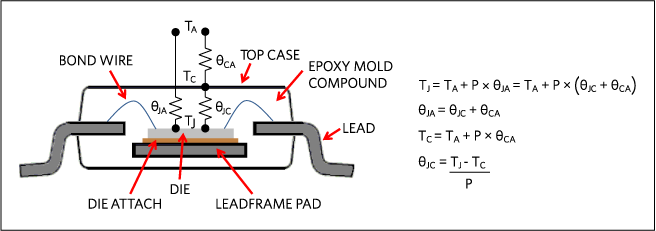Package Thermal Analysis Calculator Tutorial
Abstract
The Package Thermal Analysis Calculator (PTA) aids in the analysis of IC package thermals to assure reliability and prevent overheating. The program is for use with an HP® 50g calculator or free PC emulator.
Introduction
Steve Edwards*, an experienced analog design engineer, has written several calculators to automate repetitive tasks. These tools are being shared to help other analog design engineers who select, specify, and characterize analog circuits. We will summarize the functionality of one such tool, the IC Package Thermal Analysis Calculator.
Package Thermal Analysis Calculator
The Package Thermal Analysis Calculator (PTA) is a program written for the HP 50g calculator that aids in the analysis of IC package thermals. Using datasheet parameters, the heat and dissipation is traced from the chip (junction), to the case, to the ambient. The power derating factor and maximum power dissipation at the maximum junction temperature is explored.

Figure 1. An industry-standard thermal model and formulas for integrated circuit devices.
The format of the PTA User's Guide (available as part of the PTA program package) provides instructions for the calculator's use, the theory and equations behind the issue, and most importantly, a practical example of its use in circuit design and analysis.
PTA allows ten parameters to be entered and nine others found as a function of the other parameters.
- Power Dissipation, P, in mW (Entered and Found)
- Junction Temperature, Tj, in °C (Entered and Found)
- Junction-Case Thermal Resistance, ?JC, in °C/W (Entered and Found)
- Case Temperature, TC, in°C (Entered and Found)
- Case-Ambient Thermal Resistance, ?CA, in °C/W (Entered and Found)
- Ambient Temperature, TA, in °C (Entered and Found)
- Junction-Ambient Thermal Resistance, ?JA, in °C/W (Entered and Found)
- Power Derating Factor, DF, in mW/°C (Entered and Found)
- Maximum Junction Temperature, TJMAX, in °C (Entered)
- Maximum Power Dissipation, PMAX, in mW (Entered and Found)
PTA finds any of nine parameters as a function of the others, making it useful for both design and analysis. These parameters appear in the PTA as shown below:

Figure 2. Package Thermal Analysis display.
The user's guide tutorial details the types of noise (white, pink, and the thermal noise in resistors) and how it is calculated.
The practical example uses PTA of the MAX5112, a 9-channel current output DAC, with regards to power dissipation to examine the suitability of a hypothetical tunable laser application. The example takes the user from entering the data to solving and finding the power dissipation for two different IC packages.
*Steve Edwards is no longer with Maxim Integrated at the time of this publication.